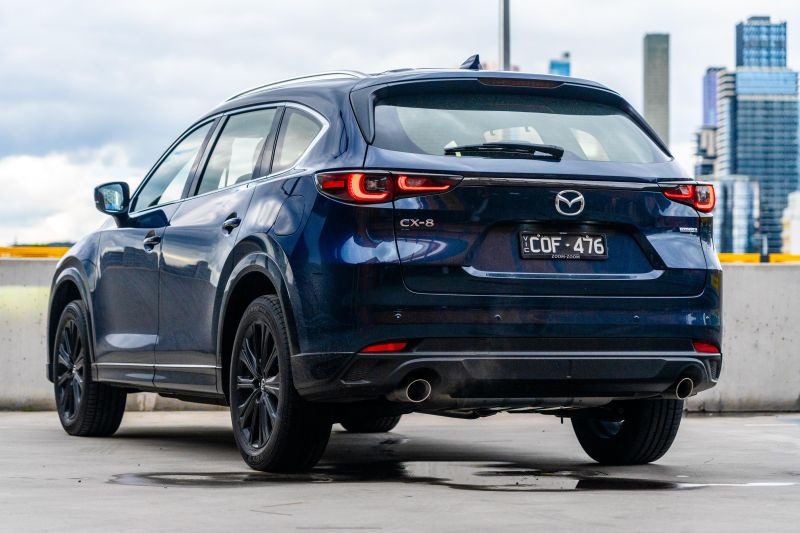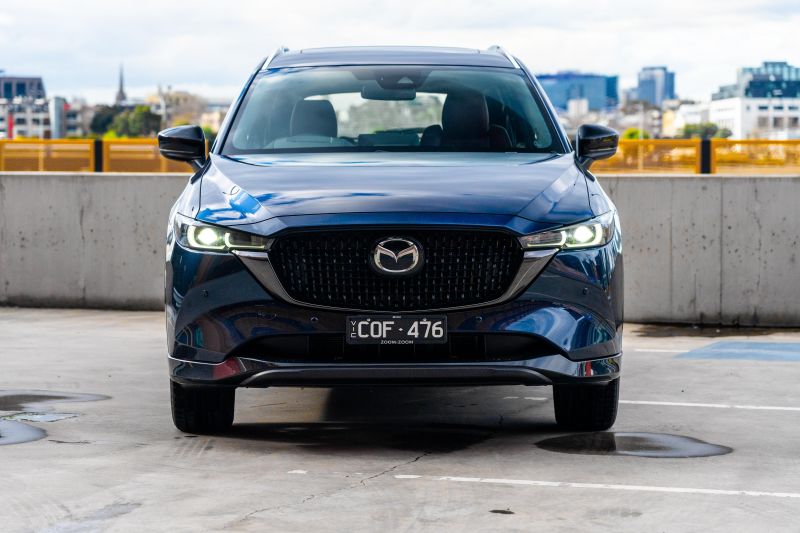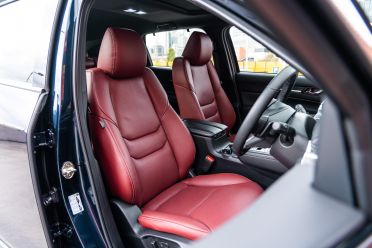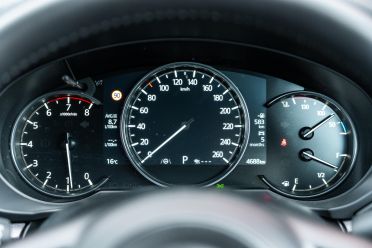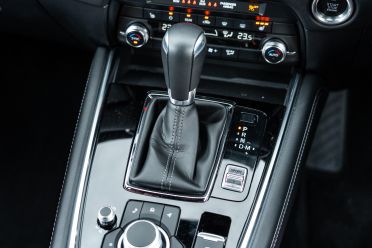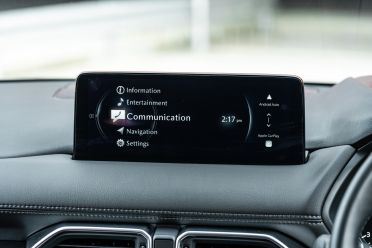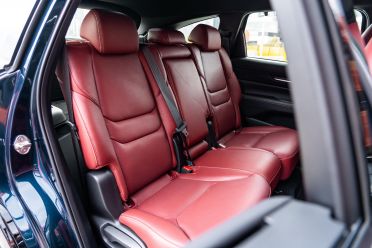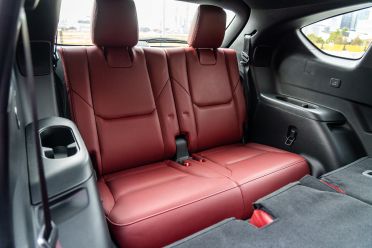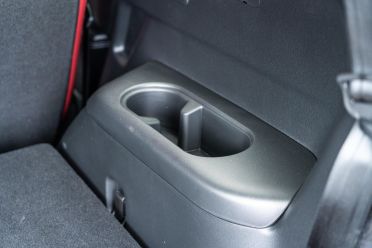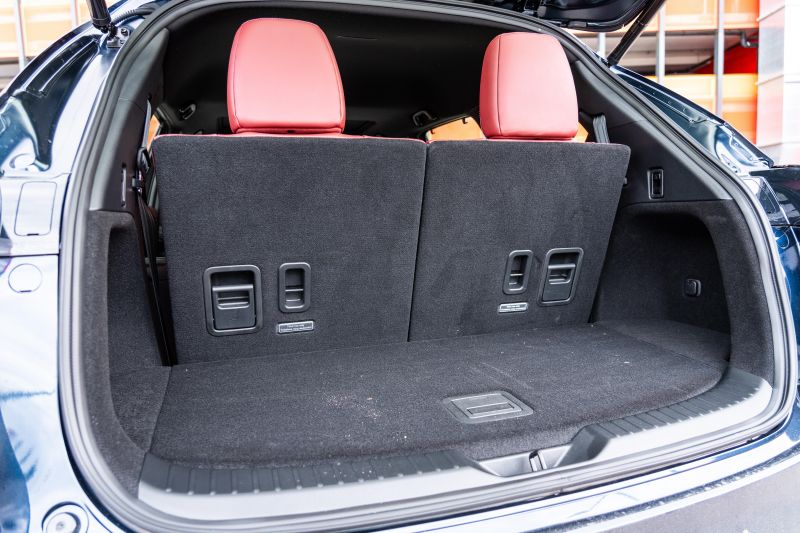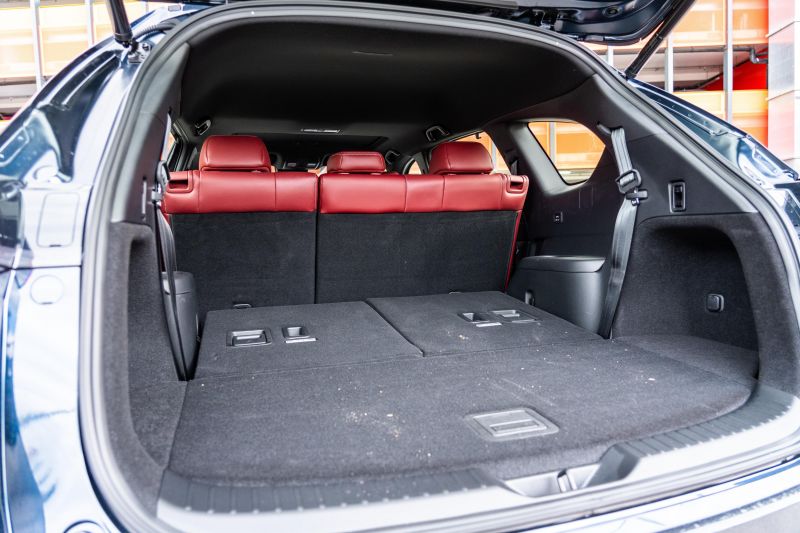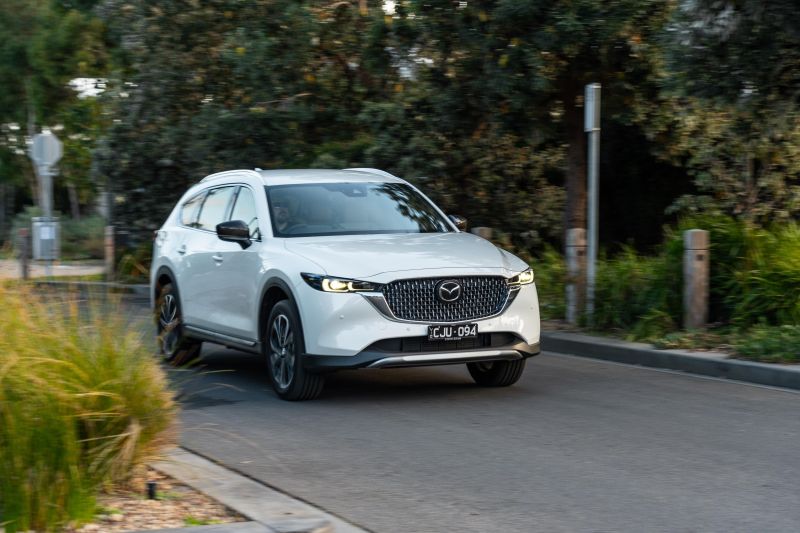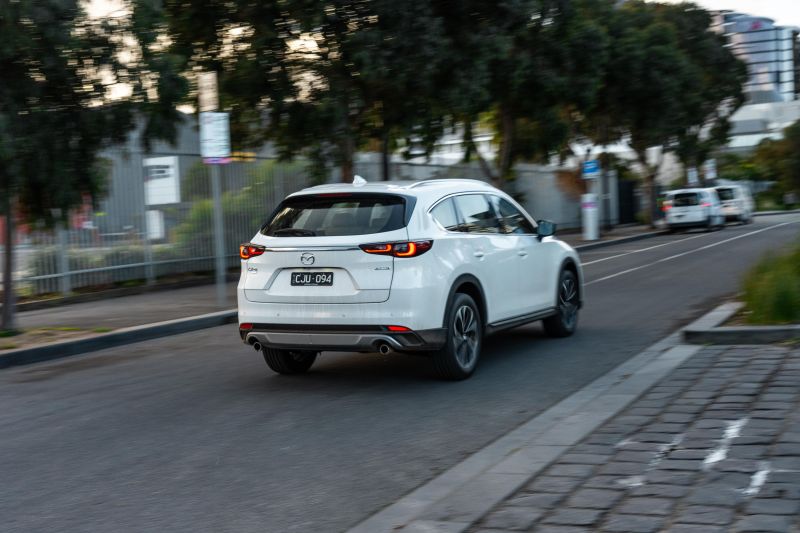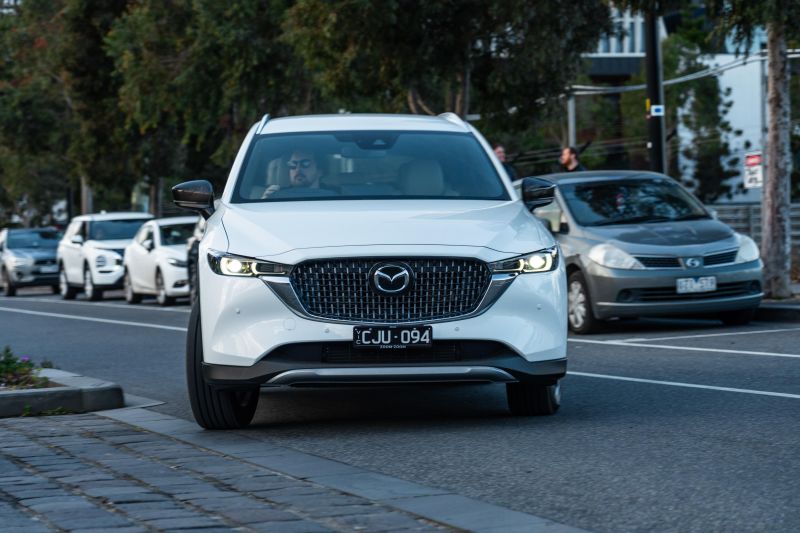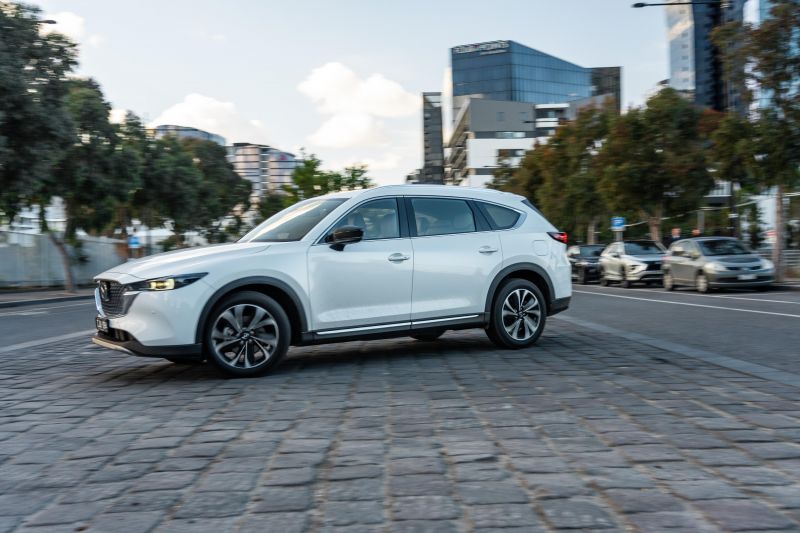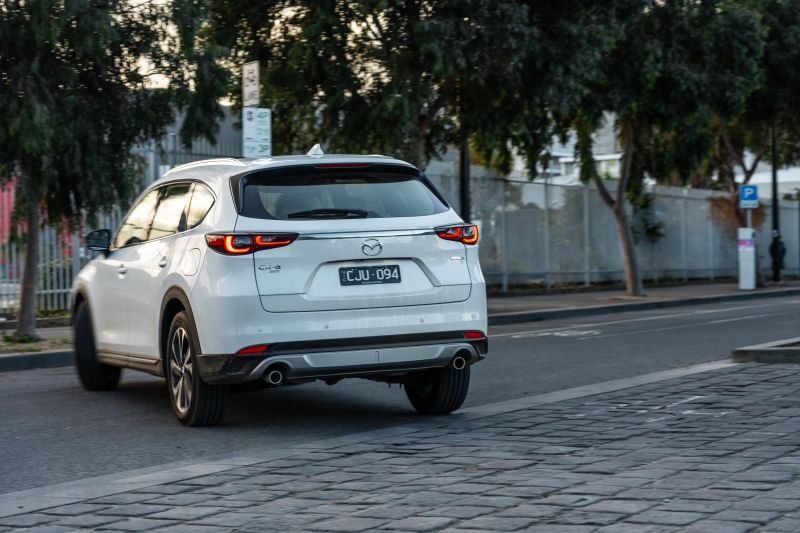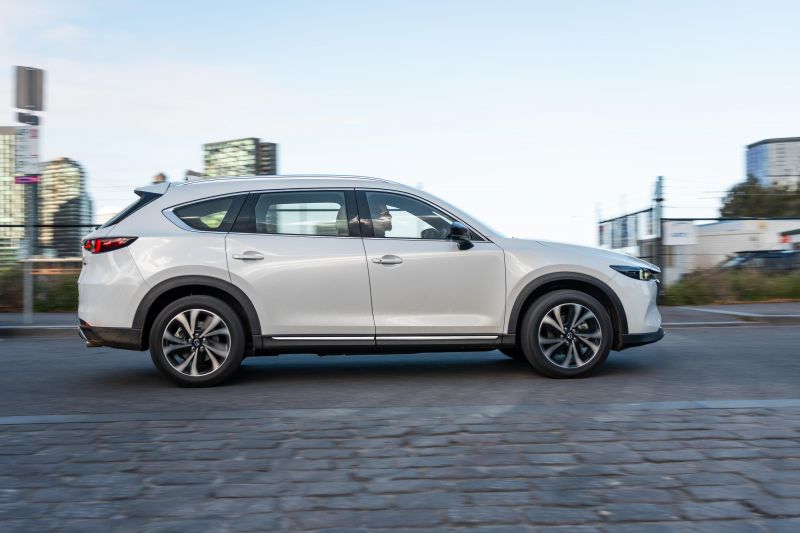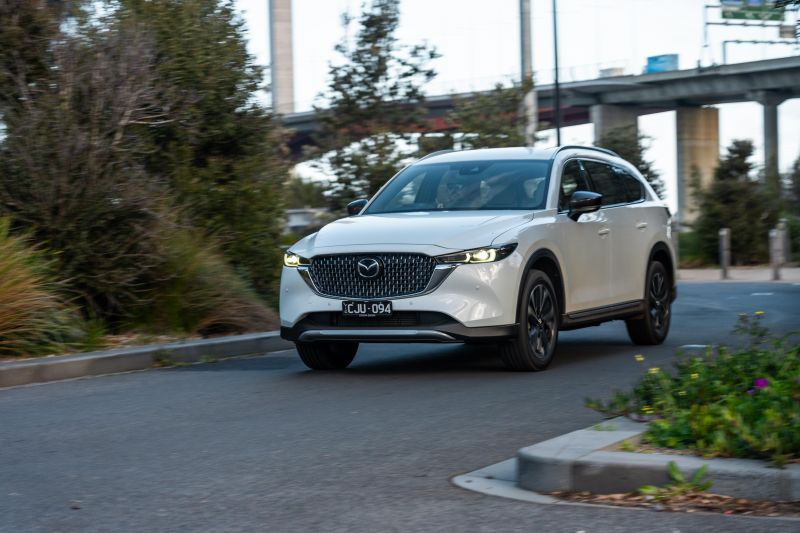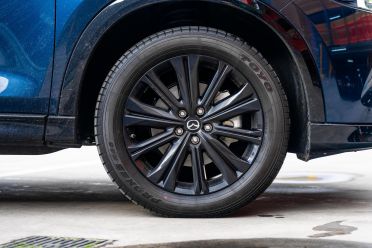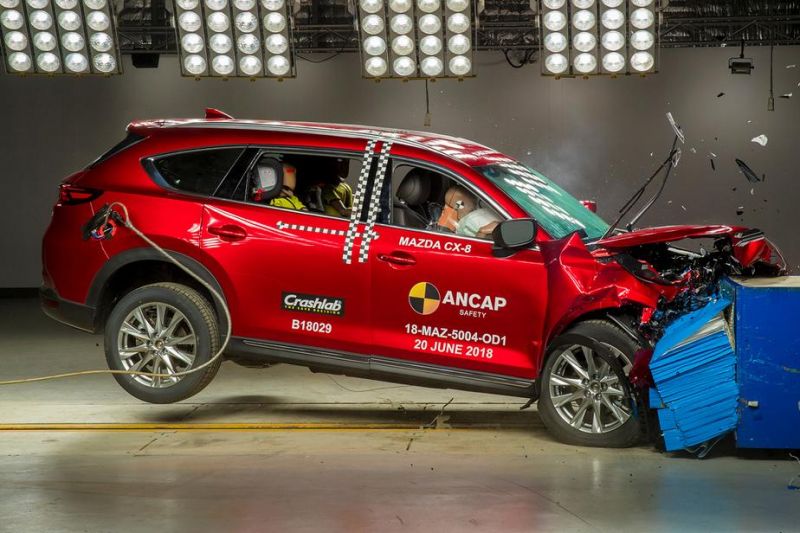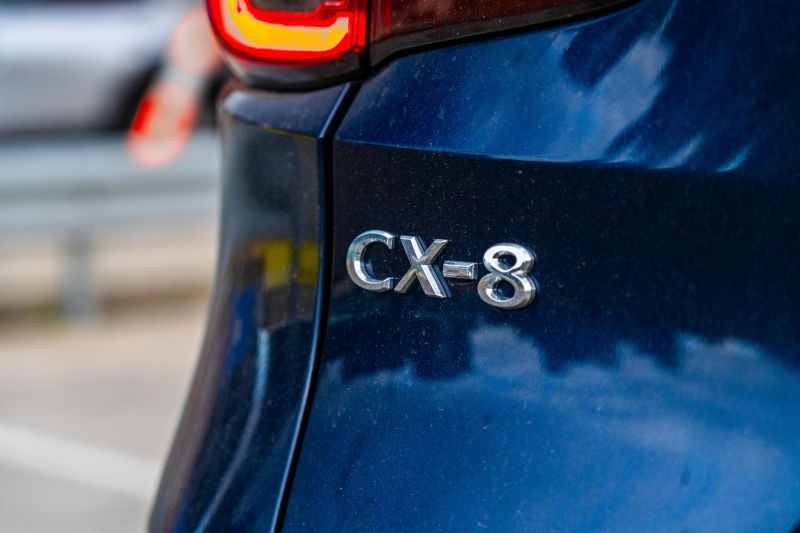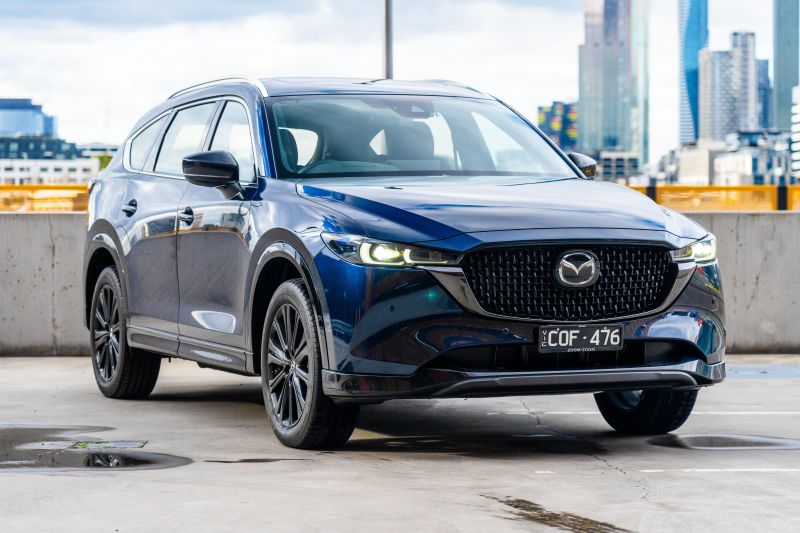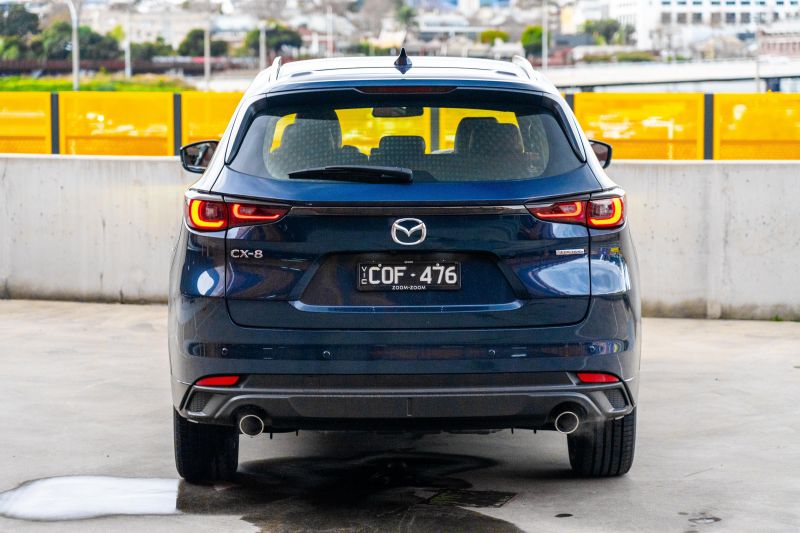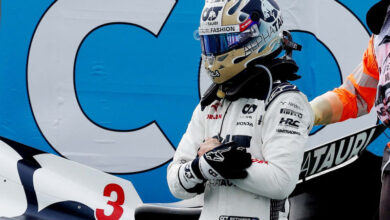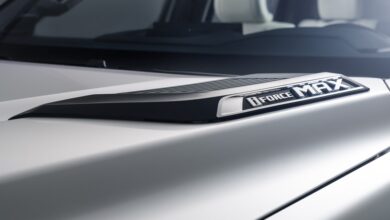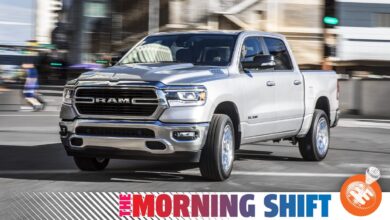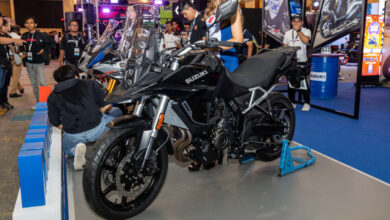2024 Mazda CX-8 G25 GT SP review
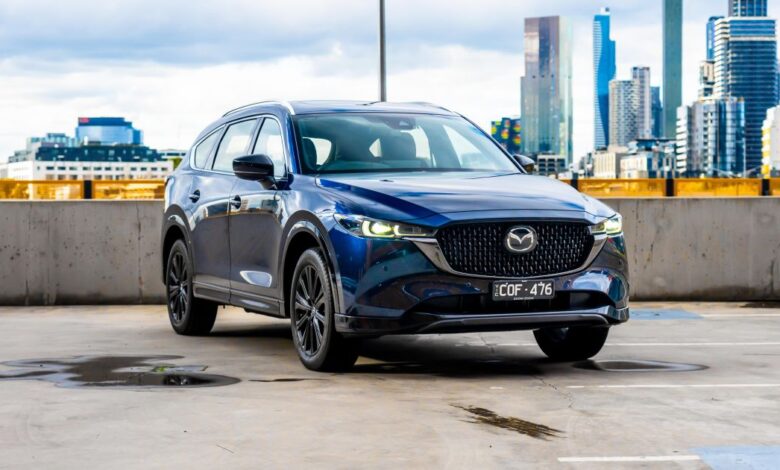
I’ll be honest – the Mazda CX-8 never really made sense to me at first.
This three-row SUV has historically lived in the shadow of the now-dead CX-9 and its proportions left it looking a little awkwardly long.
Personally I also couldn’t shake the image that it’s an elongated CX-5 with CX-9 elements to make it appear more substantial.
With this in mind, I never properly paid attention to the CX-8. At the time I barely noticed the facelift it received in 2023 that aligned it stylistically and technologically with the CX-5.
All this changed however once I got behind the wheel. I’ve sampled multiple different CX-8 grades now, as well as both petrol and diesel powertrain options. They’re all worth considering if you want proper three-row SUV that’s not overly massive.
Mazda has discontinued the CX-8, but there are still examples available at the brand’s local dealers on runout.
Should you snap a new one up before they’re gone for good?
How does the Mazda CX-8 compare?
View a detailed breakdown of the Mazda CX-8 against similarly sized vehicles.

Mazda
CX-8
How much does the Mazda CX-8 cost?
On test here is the blacked-out GT SP variant with the more affordable G25 petrol powertrain.
| Model | Price before on-road costs |
|---|---|
| 2024 Mazda CX-8 G25 Sport | $42,810 |
| 2024 Mazda CX-8 G25 Touring | $49,710 |
| 2024 Mazda CX-8 D35 Sport AWD | $49,810 |
| 2024 Mazda CX-8 D35 Touring Active AWD | $57,660 |
| 2024 Mazda CX-8 G25 GT SP | $59,310 |
| 2024 Mazda CX-8 G25 Asaki | $62,560 |
| 2024 Mazda CX-8 D35 GT SP AWD | $66,310 |
| 2024 Mazda CX-8 D35 Asaki AWD | $69,560 |
| 2024 Mazda CX-8 D35 Asaki LE AWD | $72,160 |
To see how the CX-8 compares with the competition, check out our comparison tool.
What is the Mazda CX-8 like on the inside?
Getting into the CX-8 GT SP you’re smacked in the face with its red leather upholstery. It looks fantastic and Mazda deserves credit for giving customers the option for something more exciting than black.
If the red seats really are too much though, Mazda does let you opt for black leather upholstery instead to match all the blacked-out exterior highlights.
Hopping into the CX-8 is easy due to the raised ride height synonymous with crossover SUVs. You can pivot in and out, rather than having to step up or down which is nice for those with limited mobility.
Once you’re sat in the driver’s seat you’re perched up high which gives you clear vision ahead. Something to note however are the thick A-pillars which can cause a bit of a blindspot when coming into an intersection.
The driver’s seat in the CX-8 GT SP offers 10 ways of electric adjustment, which is plenty. I appreciate how much thigh support you can dial in as a person with long legs. There’s also two-position memory which is good if multiple people drive the car.
Both the front seats are heated and in their hottest setting they get really warm. On longer drives I found myself flicking back to the medium setting so I didn’t roast myself.
It’s worth noting the CX-8 GT SP doesn’t come with ventilated seats. You need to step up to the flagship Asaki and Asaki LE trims in order to get this functionality.
Ahead of the driver the steering wheel is classic Mazda fare. The rim fills your hand nicely and the leather wrapping feels soft and supple. The only thing it’s missing is heating, which is another feature you need to step up to the Asaki or Asaki LE to receive.
Behind this is an instrument cluster that will likely look very familiar if you’ve sat in a Mazda vehicle from the last few years. There are two crisp analogue dials on each side of the instrument cluster, as well as a 7.0-inch display in the middle.
Although the latter of these is crisp and clear, there isn’t much functionality to it. There are only a few infographic screens you can cycle through and the majority are filled with negative space.
There’s a bright head-up display which allows you to keep your eyes on the road. Unlike some head-up displays from other brands it shows upcoming give way and stop signs, as well as the signposted speed limit.
Moving across there’s a large 10.25-inch infotainment system that offers high resolution and has snappy processing. The latter means the screen boots up quickly upon startup and new pages load quickly.
Unlike the related CX-5, the CX-8 never regained touch functionality on the infotainment system. Instead you’re limited to using the older-style rotary dial controller to navigate through the menus.
Thankfully the native Mazda Connect infotainment system is very familiar and it’s hard to get lost in the menus.
The issue with being limited to using the rotary dial arises when smartphone mirroring is connected. In Apple CarPlay in particular, you need to spin the dial seemingly endlessly to navigate through lists and menus.
Speaking of smartphone mirroring, the CX-8 comes with wired and wireless versions of both Apple CarPlay and Android Auto. With my iPhone 15 Pro Max connected wirelessly I didn’t experience any major dropouts.
When I had my plus-sized phone placed on the wireless charger however, it would cause the wireless smartphone mirroring to stutter badly. It was like my phone was overheating, which isn’t an uncommon thing that happens for me with car wireless chargers.
I will say the placement of the CX-8’s wireless charger is much better than the CX-5’s as it doesn’t have that awkward lip that barely holds your phone in place. Instead there’s a nice nook, but evidently the coils inside the wireless charging pad still aren’t able to properly align with my phone.
Looking around the cabin the CX-8 marries the best parts of the CX-5 with the now-dead CX-9. I particularly like the higher centre console with the split armrest as it feels plush and premium.
There are plenty of soft touches around the cabin in the GT SP, including the armrests, dashboard and also where you knees rest. Harder plastics are present lower down though, which is to be expected in a vehicle at this price point.
Besides the red seats fitted to our tester, there are plenty of black finishes around the cabin which can arguably make it feel a tad boring. Thankfully there’s a (somewhat small) sunroof that helps make the cabin feel airier.
Moving to the second row the large doors open to almost 90 degrees, which is great if you need to fit child seats or clamber into the third row.
Once your sat in the second row there’s a generous amount of space.
The bench slides and reclines with a 60/40 split, which in its rearmost position there’s plenty of head-, shoulder-, leg- and toe room. You can even slide the bench forward a fair bit to allow for more space in the third row.
Two adults fit across the second row easily and three could fit at a pinch. The CX-8 isn’t as wide as the American-focused CX-9 though, so this is something to keep in mind.
Second-row amenities include a separate zone of climate control with air vents on the back of the centre console, heated outboard seats, and a fold-down armrest with cupholders and two USB-A ports.
Getting into the third row of the CX-8 is easier than I thought. It’s not something that I’d want to do often but the wide rear doors make it an easier process.
If you plan to have adults sit in the third row of the CX-8 you’ll need to have the occupants in the second row slide their seat forward a tad. If you don’t, things are way too cramped.
At a leggy 182cm I had an okay amount of leg- and foot space, though head- and shoulder room was limited.
Ultimately the third row is better as a kid-only space, or seats that you only use in emergencies.
This is made pretty obvious by the lack of amenities back there. There are plenty of hard plastics, no air vents, though the GT SP does get two USB-A ports.
Down back the CX-8 GT SP is the most affordable variant to pick up a power tailgate. It opens up quickly and reveals a surprising 209 litres of boot capacity with all three rows of seating upright.
There’s also a small underfloor storage that’s handy if you want to key something proper out of sight. If you don’t use the third row of seats often, there’s oodles of boot space in five-seat mode – 775 litres in fact.
Something to note however is there isn’t a proper load cover blind in the CX-8, so anything you leave in the main boot section is visible to onlookers.
Lastly, the CX-8 comes with a space-saver wheel that’s tucked under the underfloor storage area and also under the third row of seating. I’m glad I didn’t have to use it because it looks very tricky to get out its housing.
Thankfully there is a spare wheel of some variety just in case you have a puncture and you’re far away from a tyre repair shop.
| Dimensions | Mazda CX-8 G25 GT SP |
|---|---|
| Length | 4925mm |
| Width | 1845mm |
| Height | 1725mm |
| Wheelbase | 2930mm |
| Cargo capacity | 209 litres (7 seats) 775 litres (5 seats) |
To see how the CX-8 compares with the competition, check out our comparison tool.
What’s under the bonnet?
Our CX-8 G25 GT SP tester is powered by a 2.5-litre naturally aspirated four-cylinder petrol engine. Unlike the turbo-diesel which comes standard with all-wheel drive, the petrol only comes as front-wheel drive.
| Specifications | Mazda CX-8 G25 |
|---|---|
| Engine | 2.5L 4cyl petrol |
| Power | 140kW @ 6000rpm |
| Torque | 252Nm @ 4000rpm |
| Transmission | 6-speed auto |
| Driven wheels | FWD |
| Weight | 1827kg (kerb) |
| Fuel economy (claimed) | 8.1L/100km |
| Fuel economy (as tested) | 9.3L/100km (230km urban driving) |
| Fuel tank capacity | 72 litres |
| Fuel requirement | 91 RON |
| CO2 emissions | 187g/km |
| Emissions standard | Euro 5 |
| Braked tow capacity | 1800kg |
To see how the CX-8 compares with the competition, check out our comparison tool.
How does the Mazda CX-8 drive?
On startup the CX-8’s naturally aspirated petrol engine roars to life a little raucously. It has a high idle that lingers until the engine warms up a tad – this is a common Mazda trait but it makes it buzzy in the cabin.
Power from this naturally aspirated petrol engine is decent but it doesn’t necessarily light your world on fire. The diesel is much more settled and refined than the petrol, and it doesn’t need to be worked quite as hard.
It would be nice if the CX-8 came with the G35 2.5-litre turbocharged four-cylinder petrol engine the CX-5 gets, but evidently you can’t have it all.
Regardless, if you’re docile with your throttle inputs off the line the G25 petrol engine will reward you with progressive and linear acceleration that’s rather subdued.
The engine is also a fairly rev-happy if you give it a bit more beans, frequently going beyond 3000rpm to get this large SUV up to speed. This makes it a bit shouty from behind the wheel as its engine note isn’t the most pleasant.
As standard there’s a six-speed automatic transmission that’s very smooth and silky. It will keep the revs down low where possible to minimise fuel consumption and lean on its (relatively small) amount of torque if it can.
When accelerating some of the gears can feel a little CVT-like, which isn’t the most engaging feeling. It would be nice if there was an extra ratio or two.
The G25 engine in the CX-8 is slightly different to the one in the CX-5 because it doesn’t have cylinder deactivation which cuts fuel use when cruising under light throttle or coasting. This makes it not quite as efficient as it could theoretically be.
Like the CX-5, There is engine idle stop-start however, which helps reduce tailpipe emissions when stationary. It’s a good system too, though conditions like the 12V battery charge, engine temperature and climate control settings have to be just right to reap the full benefits.
Even though the CX-8 is heavier and much longer than the CX-5 it still feels rather nimble. It’s actually a rather dynamic SUV to chuck around corners, though its extra heft is noticeable on sweeping bends.
Mazda has done a great job at tuning the CX-8’s suspension because it’s largely very comfortable. It settles quickly when you’re travelling along pockmarked city streets, though harsher singular bumps can feel a little brittle.
The latter is likely due to the CX-8 GT SP being fit with larger 19-inch alloy wheels. Although they do look nice, the ride would likely be even more comfortable if there were smaller 18-inch wheels with thicker tyre sidewalls.
Cruising around town the CX-8 is noticeably quieter than the CX-5. It seems like the former has more sound insulation and thicker glass to help insulate the cabin from outside noises.
This can also be felt as the CX-8’s doors are slightly harder to close than the CX-5’s as there’s extra rubber sealing.
Despite the CX-8 feeling like a smaller, dynamic car than it is on the road, you can’t escape it when it comes to parking this almost 5.0-metre-long SUV.
This is emphasised as the CX-8 has steering that errs on the heavier side. It makes twirling the wheel a bit of an arm workout which gets tiring quickly.
As standard the CX-8 GT SP comes with front and rear parking sensors, though disappointingly it only has a reversing camera. Thankfully the latter has decent quality, though if you want a surround-view camera you need to step up to the Asaki or Asaki LE.
Building up the speed in the CX-8 is where its naturally aspirated petrol engine starts to feel out of its depth. It feels breathless with just me in the car accelerating up to 100km/h, and it doesn’t have much else to give when overtaking.
I imagine adding extra weight to the car would make it considerably slower. If you plan to load up the CX-8 with people and luggage, the turbo-diesel engine is the better choice as it’s less stressed.
The turbo-diesel is also more efficient for long distance and highway travel. At speeds above 80km/h the petrol engine often consumes around 10L/100km just cruising on level ground with one person and minimal luggage in the car.
At 100km/h the CX-8’s naturally aspirated petrol engine revs at around 2500rpm which is a touch too high for my liking. It would be nice if there was a seventh gear ratio for more subdued highway cruising, though it would likely drop back to sixth often in order to maintain speed.
Despite these gripes the CX-8 is still a very easy car to drive at higher speeds. It soaks up the kilometres with ease and holds the road well.
On the safety front the adaptive cruise control system is good but not segment-leading. It likes to brake early when it detects a car in front, and will also leave a generous gap on the closest distance setting which other cars cut into often.
The lane-keep assist is subtle in terms of how warns and guides you back into the lane after drifting out, though it can get confused at times. I noticed this most on wet roads where the lane markings are virtually indistinguishable.
The CX-8 GT SP is the most affordable variant in the range that picks up Mazda’s Cruising and Traffic Support, which essentially combines adaptive cruise control with a more sophisticated lane centring system.
This function is best left for well-marked highways and freeways as it can get a little lost and jerk at the steering wheel at lower speeds.
Lastly, the CX-8 GT SP has bright LED headlights that pick up a super cool swivelling function when you turn the steering wheel.
It’s very similar to what Subaru offers in the Forester and Outback and is great at illuminating things around corners.
This swivelling headlight function comes at the cost of this particular variant not offering adaptive high-beams. If you want this function you need to step up to the Asaki or Asaki LE.
What do you get?
On test here is the CX-8 G25 GT SP with the burgundy leather upholstery option.
CX-8 Sport highlights:
- Automatic LED headlights
- Automatic high-beam
- Heated, power-folding exterior mirrors
- Rain-sensing wipers
- 60:40 split/fold second row and 50:50 split/fold third row
- Black cloth upholstery
- Tri-zone climate control
- 7.0-inch instrument cluster screen
- Leather-wrapped steering wheel and shifter
- Tilt and telescopic steering wheel adjustment
- 2 x front USB-C charging ports
- 10.25-inch infotainment system
- Wireless Apple CarPlay and Wired Android Auto
- DAB+ digital radio
- Satellite navigation
- 6-speaker stereo system
- Keyless start
- Two ISOFIX ports and five top tether points
- Cargo area 12V outlet
CX-8 Touring adds:
- 8-way power driver’s seat
- 6-way power passenger seat
- Two x USB-A charging ports in second row
- Black leather upholstery
- Keyless entry
- Front parking sensors
CX-8 Touring Active adds:
- 19-inch black machine-finished alloy wheels
- Adaptive front-lighting system
- LED daytime running lights
- 10-way power driver’s seat
- Heated outboard second-row seats
- Revera Stone Maztex/Grey Cloth upholstery
CX-8 GT SP adds:
- 19-inch black alloy wheels
- Power tilt and slide sunroof
- Power tailgate
- Gloss black front grille
- Wireless phone charger
- 10-speaker Bose premium sound system
- 2 x USB-A charging ports in the third row
- Second row window sunshades
- LED interior lighting
- LED vanity mirror lighting
- Black or burgundy leather upholstery
- Cruising and Traffic Support (lane centring)
Is the Mazda CX-8 safe?
The Mazda CX-8 has a five-star ANCAP safety rating based on testing conducted in 2018.
| Category | Mazda CX-8 |
|---|---|
| Adult occupant protection | 36.7 out of 38 (96 per cent) |
| Child occupant protection | 42.7 out of 49 (87 per cent) |
| Vulnerable road user protection | 34.8 out of 48 (72 per cent) |
| Safety assist | 9.6 out of 13 (73 per cent) |
Standard safety equipment includes:
- Autonomous emergency braking
- Adaptive cruise control
- Blind-spot monitoring
- Driver attention warning
- Intelligent speed limit assist
- Lane departure warning
- Lane keep assist
- Rear cross-traffic alert
- Rear parking sensors
- Reversing camera
- Traffic sign recognition
- Tyre pressure monitoring
- Front, front-side and curtain airbags
Touring and up get front parking sensors, while GT SP and up get Cruising and Traffic Support, and the Asaki and Asaki LE also receive a surround-view camera.
How much does the Mazda CX-8 cost to run?
The Mazda CX-8 is backed by a five-year, unlimited-kilometre warranty.
| Running costs | Mazda CX-8 G25 |
|---|---|
| Warranty | 5 years, unlimited kilometres |
| Roadside assistance | 5 years |
| Service intervals | 12 months or 15,000 kilometres |
| Capped price servicing | 7 years |
| Total capped price service cost | $3207 |
CarExpert’s Take on the Mazda CX-8
I may have considered the Mazda CX-8 an ugly duckling at first, but this three-row SUV has grown on me to a point where I would personally consider buying one.
The GT SP’s interior with the burgundy leather upholstery looks properly lush and there’s a surprising amount of space even with all three rows upright. I also love the swivelling LED headlights as they’re really helpful at illuminating potential dangers around bends.
While I understand the petrol powertrain as tested here is perceived as cleaner than the diesel, the latter really is the pick of the lineup. Its zestier outputs better suit load-carrying and overall it just makes the driving experience more effortless.
If you can find a diesel-powered CX-8 still in stock at a Mazda dealer it’s absolutely worth considering if it suits your needs – you won’t be disappointed.
Ultimately the end of Mazda’s affordable seven-seat SUVs is nearing. If your local Mazda dealer can no longer source you’re preferred CX-8 you’ll now be forced to step up to the more luxury-oriented CX-90 or wait for the CX-80 to arrive later this year.
Click the images for the full gallery
MORE: Buy a Mazda CX-8
MORE: Everything Mazda CX-8
